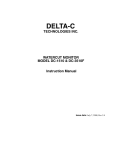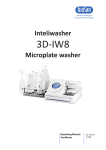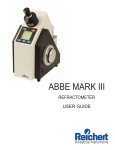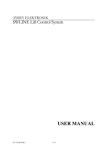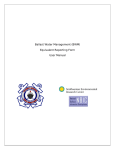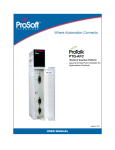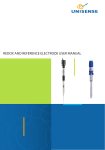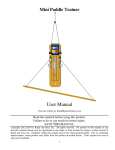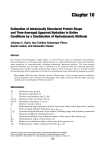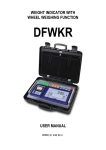Download to the PDF file.
Transcript
OPERATION DETAIL OF THE PHASE DYNAMICS UNIT How does it work? The electrical characteristics of the water (68-80) and the oil (2.5) are very different and this provides the means to clearly determine the water content. An electrical signal is sent from the electronics on the end of the measurement section down through the fluids. This generates a standing wave similar to the vibrations of a rubber band held at both ends and plucked. This standing wave changes position within the section as the water content changes. The change in position is automatically detected by the microwave oscillator that originally sent out the signal and it changes its basic frequency depending upon how much water is in the section. In summary, the sending and receiving portion of the electronics are the same and they change the frequency with respect to water content. Capacitance Measurements - What is the Problem? The key factor missing in prior technology was enough sensitivity to effectively make a good measurement. Capacitance measurements are good enough for 0.5% to 15% measurements as long as the medium under measurement does not absorb much of the low frequency energy. Some crudes do absorb energy and therefore the measurement becomes more difficult for standard technology since this further reduces the sensitivity. Capacitance measurement is a single factor measurement, it just measures the amount of energy stored between two metal plates. This limits the capability of this type of measurement. Microwave Measurement – THE OLD WAY Microwave energy provides for a more complex measurement and provides enough information to improve the measurement to include absorptive crudes. Once the absorption becomes too great (such as in the water continuous phase), the measurement once again degrades to a point where the resolution of the parameters are too small to be effective. An additional problem with standard microwave methods still being used by competitors is the complexity of the equipment required to make the measurement. A stable oscillator with amplifiers is used to obtain the frequency and microwave energy for the measurement. A sample must be obtained of the energy leaving the system to compare to the energy transmitted or reflected in the measurement section. The energy must then be transmitted across a barrier (a seal plug or the like) into the fluids under measurement. The introduction of this energy must be done in accordance with electrical design constraints in order to actually get it into the fluids instead of reflected back into the source. This is comparable to the lens of a camera. The more expensive camera lens has special coatings which prevent reflections and therefore get more light through the lens and onto the film. The energy then enters the fluids and propagates along the structure of the measurement section which is again designed to allow proper electrical properties to contain and control the energy. Typically, an additional barrier (microwave window and seal plug) and the associated structure to allow the energy to be received must be introduced into the measurement section. This allows the energy which has now been affected by the fluids under measurement to be sent back to the electronics and measured and compared to the energy originally sent out. Page 1 of 7 © Phase Dynamics, Inc. Operational Detail 0205 The measurement at this point takes the energy incident upon (introduced into) the measurement section from the oscillator and amplifiers and compares it to the received energy. This is done with additional amplifiers, amplitude detectors, phase detectors, mixers and local oscillators for the down conversion. This is technology which is standard in many military and commercial communication systems. The problem here is twofold; one is the complexity of the system, and the second is that all of this still doesn't give the required sensitivity for obtaining a good measurement in the water phase and in other situations. The complexity of standard microwave systems lead to: A.) short time between failures B.) difficulty of maintenance (most electronic technicians cannot troubleshoot such a system) C.) expense of the parts D.) the requirements for two microwave "windows" into the fluid E.) sensitivity is still reduced from what is required Typically, these systems obtain increased sensitivities by using a resonant structure (similar to an organ pipe, the length and diameters determine the note or resonance). The microwave energy is introduced into the fluids and the measurement section is designed as the resonant structure. The problem with a resonant structure is that it goes away when you introduce absorptive materials (such as salt water or some crudes). This is like placing a rubber plug into the organ pipe, the strength of the vibrations is vastly reduced and the clarity of the tone is gone. Another method is the use of antenna structures inside the diameter of the pipe carrying the liquids to send and receive the signal. This is difficult to accomplish without reflections in the pipe structure and these reflections then lead to adding and subtracting of the signal randomly. What Benefits does Oscillator Load Pull Have? What is required to make a good measurement comes down to reduction of the complexity and improvement of the sensitivity. Oscillator load pull is a parameter of an oscillator which is a measure of how much the oscillator changes its frequency when the load that is connected to it changes. This is a parameter which is usually designed out by preventing the oscillator from ever seeing the changing load though the use of isolation means. Typically amplifiers will be used after the oscillator to isolate the oscillator from the load. This is like a guard rail around the pipe organ's pipes to prevent people from touching the pipes and therefore changing their tone. Interestingly, no one ever used load pull for a measurement before, they just always knew that they needed to design it out. Therefore, a patent was issued on this technique. The advantages of load pull are simplicity, the source of the microwave frequency and energy is both the transmitter and the receiver. In addition, the use of oscillator load pull increases the sensitivity to the measurement parameters by 100 to 1000 times over conventional microwave measurement techniques. This increase in sensitivity also brings the capability to measure highly absorptive fluids such as 28% salt in water. Because of simplicity the entire system is very easy to trouble shoot and is very stable and reliable. What makes Phase Dynamics Different from Other Technologies? The patented measurement method which allows the oscillator to change frequency with the Page 2 of 7 © Phase Dynamics, Inc. Operational Detail 0205 changing water cut provides for up to 1000 times the sensitivity than other technologies. This is the reason that water continuous measurements in the high water cut region can be done. Prior methods just did not have the sensitivity to water in the 60-90% water cut regions. This same method gives long term reproducibility and stability of measurement because of the simplicity of the circuitry. The engineering, materials, and methods are based on a military style of design. Connectors, board layout, and designs follow methods which were learned during employment with Texas Instruments in the military electronics divisions. What can the user check on the Measurement Section? The only items that can be checked on the measurement section is the tightness of the oscillator housing, the RF front connector, and the RTD temperature probe connections. The oscillator housing has brackets on both sides to prevent vibration from loosening the RF Connector. The Measurement Section has the serial number on the end metal plug, the oscillator has a separate and different serial number on the end of its housing. Please use the serial number on the pipe section end when referring to the unit in correspondence, by fax, or service call. The microwave electronics is a sealed box in order to prevent moisture from the air from getting inside. The circuitry is surface mount components because of the high frequencies involved and therefore, is not user serviceable. The measurement section and the oscillator are calibrated together and are considered a single unit. A unique EPROM is created for each unit with the calibration curves generated at the factory. If the measurement section (and electronics) has some technical problem, the main electronics can be used with another section if the replacement unit's EPROM is changed out also. The measurement section has a serial number stamped on the blank end which is also noted on the EPROM. These must match. In addition to the electronics, a 100 ohm RTD platinum temperature probe is placed into the fluids just below the flange. This is connected to the electronics through a terminal block. The Swage Lock fittings are packed with sealant. The entire RTD and Swage system is typically replaced as a unit. If the RTD is shorted a 100 ohm resistor can be placed between P2 and P3 with jumpers between P+ and P2, and another between P3 and P4 to obtain temperature while the assembly is obtained and replaced. A suitable value may be used to obtain a close to fluid temperature reading to maintain temperature compensation. Installing a temporary resistor also verifies that the analog input board is operating correctly. What is the calibration and how is it done at the factory? The electronics and the measurement section are mated and placed on a fluid loop where the calibration curves are generated. To obtain the oil continuous phase curves (water droplets are surrounded by oil as the continuous phase), the loop is loaded with oil and brought to temperature. Water is injected into the recirculating oil at a known rate with a computer system keeping track of both water cut and the specific frequencies generated by the oscillator. To obtain the water curves (oil droplets surrounded by water as the continuous phase), the loop is loaded with water of a given salinity and then oil in injected at a known rate. The loop computer again keeps track of the water cut and the frequency of the oscillator at each water cut. Many runs are made with various salinities in order to fully characterize the pipe and the electronics mated with it. This data is then curve fit into various curves of water cut, frequency, salinity, and temperature and then placed into EPROM as polynomial equations. This is the data set that is selected when a salinity calibration is performed in the field. In the field, inversion from oil continuous phase to the water continuous phase occurs between 60% and 90% water content and depends on the salinity, temperature, and makeup of the crude oil. Page 3 of 7 © Phase Dynamics, Inc. Operational Detail 0205 What are the considerations in mounting and use? 1.) Flow Rates and Mounting of the Measurement Section The orientation does not matter if the flow rate is above approximately 2-3 feet/second. This assures a homogeneous mixture in the measurement section. If there is gas present, the preferred orientation is with the electronics end down and the flow from the bottom to the top. This assures that the free gas is removed from the section instead of accumulating it at one end. If the flow rate is very low (below 1 ft/sec), then the preferred orientation is the electronics upward and the flow from the top to the bottom. This is so that the water does not accumulate in the section. If the section is mounted horizontally and the low rate is low sand may also accumulate in the section. Flow in the main line must be high enough to prevent separation for a low water cut unit where a hot tap on the side of a pipeline with a pitot tube in the upstream section is used. The measurement section should not be at the lowest or the highest place in a piping line unless due consideration is given to the hold up of water, oil and gas (by maintaining high flow rates). 2.) High Temperature Units For high temperature (>100º C fluid temperature) operation, the electronics should be mounted football down due to the necessity of keeping the electronics portion below 120º F ambient. Otherwise, the heat rises and prevents the aluminum explosion proof box from radiating the heat to the ambient air. The electronics includes a very small built in heater to keep the electronics, which are temperature sensitive, at a temperature of 160ºs F. As the enclosure temperature (around the electronics) gets above approximately 120º F, the heater starts to regulate less. Above 140º F, the heater must almost shut down causing greater temperature changes at the circuit and therefore, there is a greater error in the measurement. There are several versions of the Phase Dynamics measurement sections for various temperature ranges. When the fully brazed system is selected for very high temperatures, the electronics on the end of the measurement section should be air purged with dry instrument air in order to maintain the oscillator at a reasonable temperature. Contact the factory about the requirements for air purging. 3.) Electrical Considerations Cables and Grounding: Included with each system are a system cable and a green grounding wire. The system cable must be pulled from the measurement section end back to the main electronics due to the military type connector on one end. The green ground wire is to meet CSA requirements and also to assure a good earth ground is obtained between the measurement section and the electronics. This prevents ground loops from being carried in the system cable's shields. In all cases, the AC Input board should have an earth ground wire connected. In addition to the safety aspects, this assures a solid instrument ground. Flow Meter Input Connections: Pulsed flow inputs need to be at least 0.030 Volts and a maximum of 15 Volts. A magnetic pickup can be directly tied in without a preamp if the cables are run in conduit and are not excessive in length. A solid ground connection must be made at the flow meter and at the Phase Dynamics' electronics in order to assure extra pulses are not obtained. Current flow inputs can be used in conjunction with other devices in the current loop only if the Phase Dynamics is the last instrument on the loop's path nearest to the ground leg. What input and output options are available? Page 4 of 7 © Phase Dynamics, Inc. Operational Detail 0205 1.) Digital Communications The RS-422 option can include a multidrop software as a purchased option so that one RS-422 line can talk to multiple units. This must be specified at the time of purchase since the standard unit does not include multidrop capabilities. When the multidrop option is implemented it becomes an RS-485. The RS-422 is implemented with ASCII protocol which is included at the back of the user's manual. 2.) 0-20 mA and 4-20 mA Outputs Standard as an output is the 0-20 mA or the 4-20 mA output of water cut. Totalization of the net oil and water can only be obtained from the digital communications buss. 3.) Well Select OPTIONAL Input using 0-20 mA or 4-20 mA An option for use of the flow 4-20 mA input as a well select is available. This option gives well selection up to 50 wells. This does preclude use of a current flow input for net oil. Water Cut Measurements and Salinity of the Water In order to make any electrical measurement of water containing salts, the salinity MUST be considered if any measurement of consequence is done. Simply speaking, the reproducibility and accuracy of the measurement is completely compromised without salinity compensation. If the fluids are in the oil continuous phase - oil surrounds the water droplets at water cuts typically less than 60% salinity does not affect the measurement. Salinity becomes an issue in the water continuous phase (above about 60% water). From the early 1950's, it has been shown and known that measurements in the oil-in-water emulsion phase are made difficult by the high conductivity of the salt water. In this phase, the oil droplets appear as voids in the conductive water and therefore, the nature of the oil does not affect the measurement. Any change in the salinity makes a large difference in the conductivity. This is in parallel with the measuring capacitance of standard capacitance and absorption probes and prevents an effective measurement from being performed. Although some probes claim to work on attenuation of the signal, the water is so conductive that the measurement is very minimal at best in the water continuous phase. A good measurement must include the effects of the salt. The 1958 Oil and Gas Journal paper by Mr. Robert S. Wood, Capacitance-type b.s. and w. recorder features automatic, continuous operation, says that when the water continuous phase is entered, the "resistance of the emulsion has dropped so low that the probe is practically short-circuited." He gives the resistance (one divided by the conductivity) for various salinity waters versus water cut. It is obvious where the water continuous phase begins. Other literature gives the equations for the conductivity vs salt and percent water. Another paper from the IEEE Trans. on Microwave Theory and Techniques, August, 1971, which gives the response for salt in water is by A. Stogryn and is titled Equations for Calculating the Dielectric Constant of Saline Water. Again it is obvious that the parameters of measurement are all dependent upon both temperature and salinity to a high degree. Salinity and temperature MUST be considered and corrected in the measurement for accuracy and reproducibility. Page 5 of 7 © Phase Dynamics, Inc. Operational Detail 0205 Phase Dynamics - Salinity Calibration Methods The Phase Dynamics Water Cut Analyzer provides two means by which to enter and determine the salinity of the produced water. 1.) Use of the Refractometer The first is through the use of a salinity refractometer. This is a hand held optical instrument which uses the principal of the greater the salinity, the greater the refraction of the room light entering the prism area of the instrument. The user obtains a clean sample of the well's produced water (oil in the water will cause the line to be fuzzy), zero the refractometer, and then determine the salinity of the produced water. a.) The refractometer is zeroed by placing distilled water on the prism area and using the adjustment screw on the top to set the blue line on zero. b.) The produced water should be allowed to cool to the same temperature as the distilled water used for the calibration. This corrects for temperature effects. The scale on the left gives a direct readout of percent salinity (010% or 0-5%) while the right hand scale is the density in grams/cc. This salinity value in percent can be directly entered into the Phase Dynamics menu for salinity. This is done when a water continuous emulsion does not exist in the well stream and a nearly correct value is required for the future time when the well will go water continuous. 2.) Salinity Calibration Mode of the Phase Dynamics The preferred method to determine and enter salinity is through the "Salinity Calibration" which is in the Phase Dynamics' Menu. A "Standard Salinity Calibration" allows the calculation of the salinity by knowledge of the water cut of the well. The refractometer measurement of salinity is used to compare the values obtained from the "Standard" salt calibration to check both the instrument's operation and the validity of the sample you will pull during the calibration. Provision for the pressing of the "Enter" push button is made while a sample is being pulled from the stream. This push button is again pressed when the sample is complete. Once the sample has been analyzed for water cut through distillation or centrifuge, the resultant water cut is entered into the Phase Dynamics unit. This allows the Phase Dynamics system to then calculate the salinity from the frequency and temperature obtained during the sample pull. The water cut entered by the operator then completes the required information to calculate the apparent salinity. The "Detailed Salinity Calibration" is the same except that the refractometer's reading is input and is then used to calculate a frequency offset which would bring the same salinity as the refractometer into use. Please use the "Standard" calibration unless otherwise requested by the factory. Solutions for Salinity Measurement Problems 1.) Refractometer Solutions If you have problems obtaining a clean water sample please order the following items from the Page 6 of 7 © Phase Dynamics, Inc. Operational Detail 0205 Cole Palmer Chemical Company. Watman 13mm ZC Syringe Filter, Cat. #6858-1327 pkg. Of 200 (approximate cost is US$1.00 each filter). The filter part number is not in the catalog but, it is a standard stocked item. The filters are small round items which connect directly to the end of the syringes. Use two filters in series if the water is very dirty and one filter cannot eliminate the oil film. Since the filter cost is very low, please discard after use to prevent contamination of new samples from the possibly higher salts from the previous sample. The refractometer is a validity check on the operation of the system and the sample integrity. If the two methods vary, it is typically due to the sample's integrity. 2.) Phase Dynamics' Salinity Calibration Solutions and Guidelines If the calculated salt from the "Standard" salinity calibration is greater than +\-20% of the refractometer's reading (i.e. you read 1.5% salt on the refractometer and the "Standard" salt cal gives you a salt of 1.0%, this is greater than -20% of 1.5%) there was a problem with the sample, its analysis or your salt make up. In this case the produced water may contain very little NaCl and instead may contain larger concentrations of less conductive salts such as Ca2Cl3. 3.) Obtaining a Valid Sample Typically, the manner in which the sample was obtained is the source of the greatest error at the higher water cuts. a.) The upstream sample port should be ahead of a mixer or have many elbows with high flow rates to assure mixing. b.) A pitot or quill should be installed in the sample port to obtain a sample out of the center of the flow. Samples obtained from the sides or bottom of the pipe may be biased either way depending upon flow and oil conditions. When in doubt the best approach is to enter a salinity of approximately 10% less than the refractometer's reading. If the sample port is located some distance in front or in back of the Phase Dynamics Measurement Section a biased sample may be obtained for two reasons: 1.) the operator cannot read the Phase Dynamics Display during the sampling to assure a constant water cut reading 2.) the process may be dynamic and due to flow conditions the sample time frame was too short to encompass the changes in water cut. This would lead to another problem where the water cut is changing rapidly and therefore an average sample would be difficult to obtain. 3.) Use the Separator to Obtain a Water Only Dump: The Phase Dynamics' system continually displays the instantaneous water cut at the previous entered salinity during the sample time frame. This should be within the operator's line of sight while the sample is pulled to observe the change in water vs time. The best opportunity to obtain a valid sample is to raise the two phase separator's fluid level to get a water dump which will last for 30-60 seconds. Then a sample can be easily obtained and validated that it was 100% water during the "Enter to Start" and "Enter to End" sample time frame. Page 7 of 7 © Phase Dynamics, Inc. Operational Detail 0205







